Amazing Facts About Wildlife
The vampire bat and some snakes have ‘eyes’ that ‘see’ heat in the place of light, says S.Ananthanarayanan
The advantage of seeing with heat, instead of light, is first, that it can be done in the night. The second thing is that an animal sometimes needs to more than only the shape of its prey, it also needs to identify a vulnerable spot, where blood flows and the
animal is most sensitive. In the case of the vampire bat, the whole objective is 25 cc of blood, so it needs to strike an artery or not at all! A paper just published in Nature, by a group of scientists in California, Maryland and Venezuela on the heat-detecting
machinery in the vampire bat, complements earlier work on the molecular bases of the same ability in snakes.

The Python
The pit vipers, as well as boas and pythons, have ‘pits’ or depressions between the nostril and the eye, which are sensitive to heat. The depression in the pit viper is a deep cavity in the upper jaw, with a narrow opening, so that it works like a pinhole camera.
Heat radiation forms an image, although rather blurred, and in the case of vipers, on a membrane that is suspended inside the cavity. The membrane is rich in nerve tissue that is sensitive to photons of infra red light, which is radiated from warm blooded
prey and the cavities act like a pair of eyes that work in the infra red. In the case of the python and the boa, the heat sensitive surface is not a membrane but the cavity lining.
There are some reasons for the evolution of a special organ like this. The first is that the eyes, which work in visible light, cannot work in the infra red. The reason is that the nerves in the eye detect light through photochemical reactions that the photons
of light set off. Infra red photons do not have the energy to be detected in the same way. The second reason is that most lens materials are opaque to infra red radiation, and hence the need for a pin-hole camera construction, which eliminates the lens. A
third reason is the need for the detection mechanism to very rapidly cool, once heat has been detected, and be ready for another signal. For this requirement, the detection mechanism needs to be different from the photochemical route followed in the eyes.
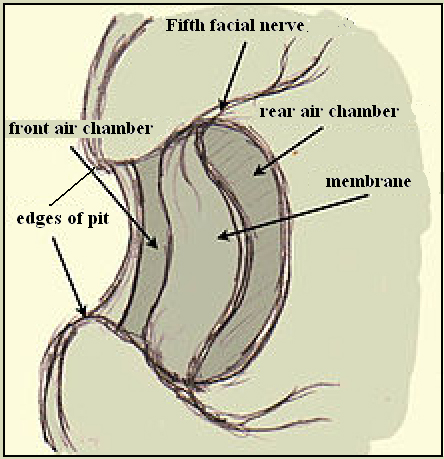
The pit
The heat detecting mechanism in the pit viper is a heat sensitive ‘ion channel’, which nerve cells use to communicate. The way nerve cells communicate is by creating changes in the concentration of their chemical contents, so that electric charges build up,
till they ‘fire’ and transfer from one cell to another. Changes in contents of cells, for charges to build, need the entry of chemical groups, called ions, through the cell wall and there are specific areas where this is possible. The ion channel called the
Transient Receptor Potential Ion channel, or TRPA1, is a feature in the cell wall, which is sensitive both to heat as well as pungent chemicals, like those present in mustard oil, and this channel is abundant in the nerve bundles found in the heat sensitive
pits.
TRPA1 in vipers has evolved to be most sensitive to IR radiation from objects at about 28° C, the temperature of a warm blooded animal. In the normal state, the nerve fibres are firing at a constant rate, because of the normal IR radiation from the surroundings.
But if there is a warm object, the heat strikes the cells and they begin firing at a faster rate. The sensitivity has been estimated to be better than 0.001°C. If the warm object continues to be present, the nerve cells adapt to normal firing at the higher
temperature, till the object is removed, when they again adapt. The time taken for adaptation is estimated to be as low as 50-150 milliseconds. When an IR photon has been detected, the nerve cell has also been warmed. To cool down the cell and keep it ready
for the next photon, the membrane in the heat sensing pit is specially provided with ample blood supply.

The vampire bat
The usual bat uses sonar, or a picture formed by the reflection of high frequency sound waves, for navigation in the night. But the vampire bat needs more than avoiding obstacles or detecting prey. It needs to find the artery of a prey animal so that it can
get its regular fix of fresh blood! The vampire bat has also evolved to use the pit mechanism to detect IR radiation. Just like TRPA1, the vampire bat uses the TRPV1 ion channel, which is common in mammals and used for detecting pungent chemicals and also
heat greater than 43°C. The nerve cells in the viper and pythons are rich in TPRA1, which is adapted for heat and at a lower temperature. It is found that the vampire bat has evolved so that TRPV1 is the active ion channel, and this has been adapted, in the
facial region, where heat detecting pits are present, to the proper temperature range.
Pit vipers usually prey on small, warm blooded animals and are efficient at detecting warms spots in the night, within a range of about a metre. An interesting off shoot is the defensive adaptation by the California ground squirrel. When a common predator,
like the Pacific rattlesnake is in sight, the ground squirrel waves with its tail, to divert the rattlesnake’s strike. A display that is not there if the attacker is another kind of snake that does not have the heat seeking equipment! Vampire bats are sensitive
to heat for about 20 cms, and use this to find spots that are not covered by fur or feathers, for instance, on their prey. There is no evidence of the prey developing defenses, like the California ground squirrel, against the vampire bat. This may be because
the bat only takes some 2 tablespoons of blood, it does not kill the victim, which are often cattle. But the bat’s saliva has agents that prevent clotting of blood, so that it can feed conveniently. Some animals have reacted by developing antibodies against
the anti-coagulants!
The studies on pit vipers and vampire bats underscore the variety of adaptation of species. Snakes are without ears, but their whole length is sensitive to movement and snakes detect ground vibrations that warn them of the lightest footfall. Their darting tongues
pan the air for samples of scents. And at closer range, they detect faint variations in temperature to complete the picture. The bat traditionally uses sonar to guide its rapid flight, and its feeding on insects, in pitch darkness. But where it needs to find
a source of blood, it adapts to detect temperature gradients, using a different molecular channel than snakes, because it got here by a different evolutionary route.
[the writer can be contacted at simplescience@gmail.com]
|
Endangered
-Vinod Rishi
Here is the eighth part of an article published by Shri Vinod Rishi in The Indian Forester. Vol.136:10. Wild Life Special. Shri
Vinod Rishi is IFS – retd. and a Former Additional Director General of Forests (Wildlife), Govt. of India;
E-mail: vinodrishi@rediffemail.com
(Continued from last month)
PART X
(4) Evaluation of the Conclusion
Derived in the Review
The bench-mark for the evaluation of census data was defective, the experiment fell short of simulating either of the two field methodologies and the inherent flaws in the design and conducting of the experiment insulated it from the field methodologies. With
only single
sample survey, the only interpretations one can arrive at are:
1) That it is difficult to count tigers from only one parameter – pugmarks from two soil substrates provided in the experiment; and
2) That the shortfall in the skills exhibited by participant in a single trial cannot be treated as the defect in the methodologies.
(B.II). Pugmarks are a reliable tiger monitoring index – can be used in estimation of tiger populations and research – Other Views:
a. In the follow-up of his Critical Review of Field Censuses in 1987, the investigator re-iterated that the pugmarks are not unique to individual tigers; they cannot be used for census, but can be used for estimates;
census is subjective and number game; the census method is not validated quantitatively on wild tigers; and the field method is vulnerable to extraneous factors
(Karanth, 2003).
I. Research on the specific points mentioned above was conducted by the scientists of the Wildlife Institute of India. The findings conclusively disproved all these contentions in 2005 (Sharma et al, 2001, 2005).
II. The study established that the pugmarks are unique to individual tigers; pugmarks can be used for population estimation of tigers; 63% of the Indian experts were 100% accurate in identifying tigers from their pugmarks;
pugmarks census technique had 100% classification accuracy in DFA & Logistic Regression models using only two variables -
Length & Width of pugmarks; and that the use of protocols can help in avoiding influence of extraneous factors (Sharma et al, 2001, 2005).
b. Based on a long-term monitoring work in Chitwan Park in Nepal since 1980, using radio-telemetry in a 100 sq km high density tiger occupancy area, Charles McDougal, a Smithsonian Research Associate, made the observation
that it was possible to distinguish the tracks of an adult male tiger from those of an adult female, and that it is possible to differentiate between adults of the same sex from their pugmarks, especially if the animal’s
feet have been injured, leaving particular patterns of the toes in relation to each other and to the pad
(McDougal et al, 1999).
c. A tiger pugmark-identity correlation field test was carried out by the scientists of the
Smithsonian Tiger Conservation Project in Chitwan tiger habitat in Nepal. It involved identification of tigers from their tracks and verifying their identity from photographs of tigers. The team established the validity of pugmark identification in 1996, and
extensively used data from tracks in their research work for over 15 years. They were confident that In
the future tiger researchers will be able to collect even greater amounts of auto-correlated data in a repeatable fashion using GPS collars, and believed that this approach will allow researchers to combine information from tracks, radio locations and GPS to
overcome the
limitations of each type of data (Smith et al, 1999).
d. If pugmarks could not identify individual tigers and leopards, how is it that Jim Corbett
did not overkill tigers and leopards in his pursuit of man-eaters, at a time when for every tiger and leopard in India today there were many times more in his times to choose from?
|
Green Defenders
Caught in Managlore
The policemen of the special forest squad of the city arrested a smuggler, and confiscated 13 tiger claws, three teeth, and whiskers of a tiger from his possession, on Wednesday August 17. The squad conducted the raid near the KSRTC bus stand here based on
advance information.
The mobile squad had been tipped off in advance about the arrival of a person named Chamaraja (55) near the bus stand, for trying to sell of the tiger claws and teeth. He is a native of Madappady in Sullia. The police team was led by sub-inspector of the forest
mobile squad, Manjunath K R.
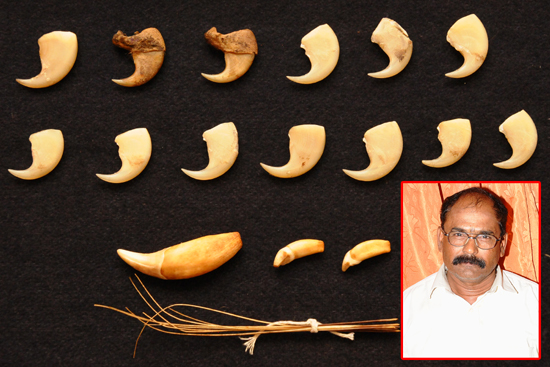
Tiger happens to be one of the most endangered animals in the world, and has been extended protection under Wildlife Act. Still, poaching of tigers has been going on in various places including tiger reserves. A case under the said act was registered in Urwa
police station. The policemen have taken up further investigation.
The local mobile squad operated under the guidance of Bangalore-based forest mobile squad inspector general of police, Narayana Gowda, and superintendent of police of Madikeri forest unit, A R Anvekar.
Link http://www.daijiworld.com/news/news_disp.asp?n_id=112467
Pic: Manju Neereshwallya
Daijiworld Media Network – Mangalore (SP)
|
News and Views
News.....
Our product store at
http://www.wildscapes.net now presents a new category "Books". You can buy eight titles by Deepak Dalal from our book store now.
Deepak Dalal chucked up a career as a chemical engineer to write stories for children. He lives currently in Pune with his wife, two daughters and several dogs and cats. He enjoys wildlife, nature and the outdoors. The Sahyadri Hills of Pune are a short journey
from his home. When not at his desk writing, he is either trekking their slopes or cycling their valleys.
The VikramAditya series of books are ideal school readers. It is breadth of the Indian experience they provide that appeals to schools. The stories take the reader on a magical journey from Ladakh to Lakshadweep, from the Andaman Islands to the Sahyadri, and
across the great forests of India. Importantly, the stories deal with critical issues like environment, wildlife and conservation. The stories create a connection between schoolchildren and wilderness areas – adding a dimension that is sorely lacking given
the urban nature of their lives today.
More than a 100 schools have used books from the VikramAditya series as readers.
For bulk orders of books, please contact
susan_sharma@hotmail.com
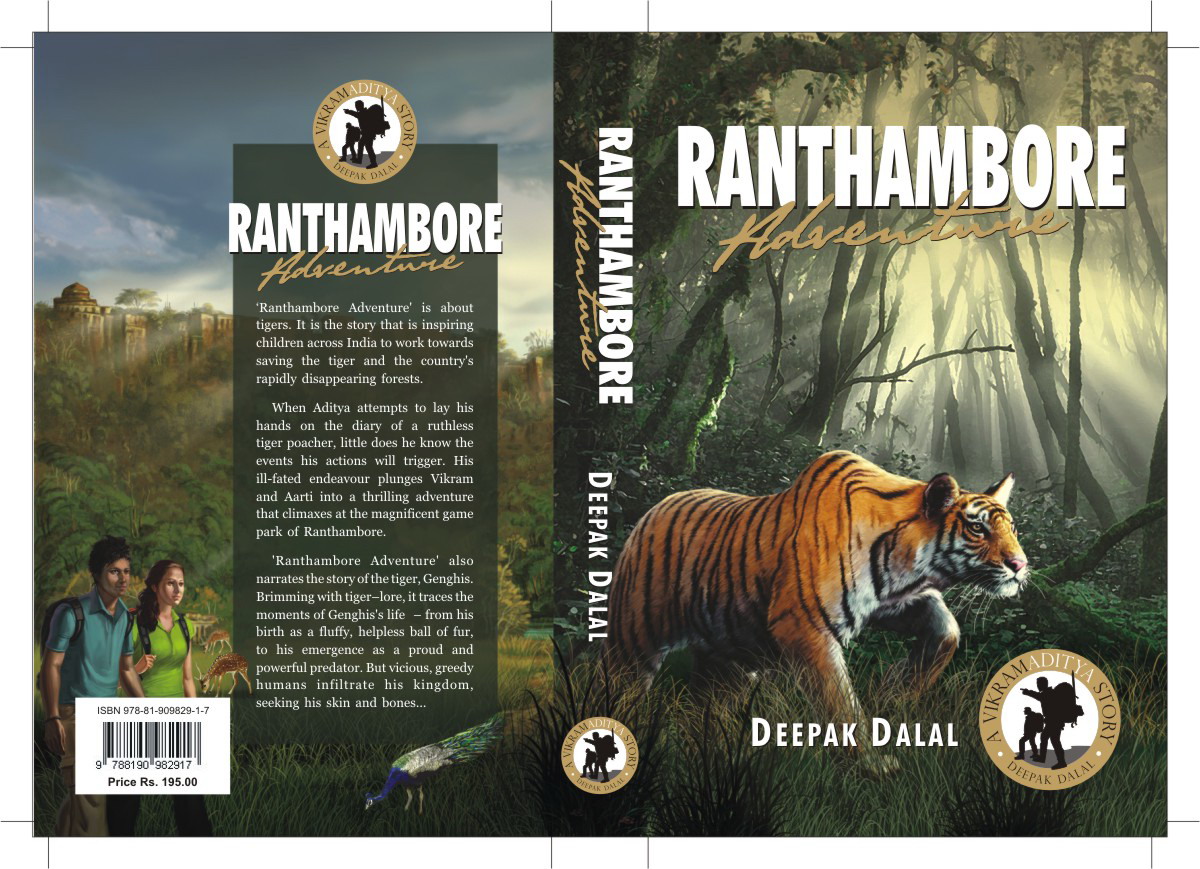
Views......
When we posted a blog on the new experiment with red ants in Kerala in the IWC blog, (Victory for banning Endosulfan) it invited a cautious comment from a well meaning member. Here is the blog and the comment
"An accidental discovery by a farmer that red ants could replace the use of pesticide to contain the attack of tea mosquito bugs in cashew plants, has prompted the Kerala Agricultural University in Kasargode to refine the ant technology for larger field application.
Entomology Department of the university has begun a three-year project on the use of red ants in vegetable cultivation to do away with the use of pesticides to curb the insects, apart from continuing the experiments in the cashew sector.

Comments by Takako Sato
That's great! :) I think using nature to take care of things that it does for FREE is always a better option then polluting our fields and waterways for generations to come! Way to go small-time farmer!
I hope they do not create or use a different species of ant then the ones native to the region. That could cause other problems down the line! It has happened so many times in the USA.
More on the red ants discovery:
N Vasavan, a small-scale farmer in the district, had brought back the ant-based biological pest control in his cashew plantation when the farm sector was heavily banking on pesticides. Tea mosquito bug is the most serious pest of cashew plantation. To contain
the bug threat, endosulfan had been aerially sprayed in the government-owned large tracts of cashew plantations for two decades. Researchers say the adult and nymph of the bug suck the sap from tender shoots, cashew nuts, fruit and other areas, reducing the
output by 50 per cent. A single nymph can cause blighting of tender shoot within four days of feeding.
Vasavan planted a new variety of cashew saplings in his small holding in 2004. After two years, red ants had formed their colonies in a few plants. When tea mosquito bugs began
attacking the plants, Vasavan used a local concoction of bio-pesticide made out of neem cake and garlic. The ants perished due to the bio-pesticide. Later, he avoided the plants where the ants had formed nestles within the leaves, said the 55-year old farmer.
He was surprised to see that the trees where ants had harboured were growing better than those treated with pesticide. Soon, Vasavan started grooming ant colonies in his cashew
shrubs.
|
Our choice from facebook this month
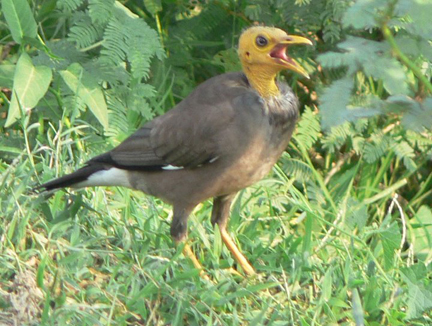
Bald mynah by Rajeev Chauhan posted in the facebook group "Indian Birds"on August 27, 2011
"Baldness in Mynahs, and subsequent yellow coloration of the skin is being observed in urban centres around the world. One dominating theory as to its cause is that human foods do not allow creation of keratin as much as natural foods (with lots more animal
protein ostensibly). Keratin is a very important requirement for birds to form feathers. Mynahs are species that do not have complete molt - that is, they do not have a period in a year where they lose most of the feathers that regrow over a short period of
time. Molting is gradual and throughout the year. Keratin deficiency can therefore cause serious consequences in terms of feather production."-Gopi Sundar
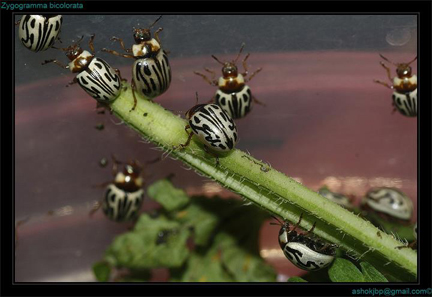
(Imported Mexican Beetle that feeds on Parthenium)Zygogramma bicolorata
Album:Photos of DiversityIndia
posted by Ashok Sengupta on August 28, 2011
"They can be a boon to our eco-system..Govt is importing them."-Ashok Sengupta
" Has there been studies on this beetle in indian ecology?? They can as well be a disaster!! This again can be a disastrous introduction of an exotic species." -Rishiddh Jhaveri
"The variations in the time taken for biocontrol agents to become abundant in places where introduced, appear to depend upon the climatic differences between the countries of origin and introduction. For example Z. bicolorata took three years in India (Jayanth
and Geetha Bali 1994) and 12 years in Australia, to have any significant impact on parthenium. ( K. Dhileepan et al in the Eleventh Australian Weeds Conference Proceedings)" - Susan Sharma
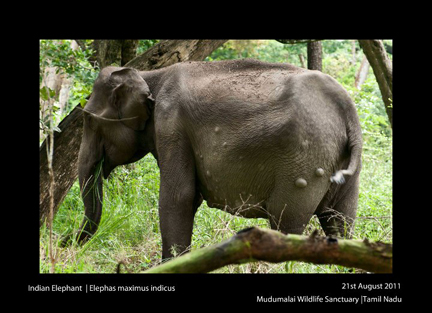
Elephant-Posted by Hj Srikanth posted in CUPA - Compassion Unlimited Plus Action, Bangalore Photo by Vijay Raman taken at Mudumalai Sanctuary
"Back indents are normal for elephants depending on their age. She does not look like shes out of condition. It could also be caused by a virus but its not likely are there any other elephants with this condition in area? I doubt its infecti...ous probably
benign skin tumors or dermal cysts only way to know for sure would be to biopsy. i have seen many types of skin lumps in elys in Africa and have seen them year after year and they dont seem to be affected by them. But each case is individual and without hands
on examination we wont know for sure."-Chobewildliferescue Botswana
"It appears to be a case of cutaneous filariasis. These are dermatological manifestations due to a nematode which migrates subcutaneously and come out through some of these nodules (usually seen along the belly and sides of abdomen). The link below has another
photo for you to compare.
http://wildlife1.wildlifeinformation.org/S/00dis/Parasitic/Img_HrgicFilaridDermatitis/HHAsEle2532_Filariasis.htm
My fellow vet Dr. Manoharan says it is not uncommon in wild elephants of Mudumalai. This is an young female whose body condition is also not that good. Usually the disease is self limiting and affected animals manage to recover once the monsoon period is over.
Cutaneous filariasis is also common among captive elephants of Eastern Assam. The disease is easily curable but the animal can get the disease again during any of the following seasons. Of course no one treats wild elephants. It is not life threatening threatening,
so no intervention is required. - Dr. N.V.K. Ashraf through Ravi Chellam
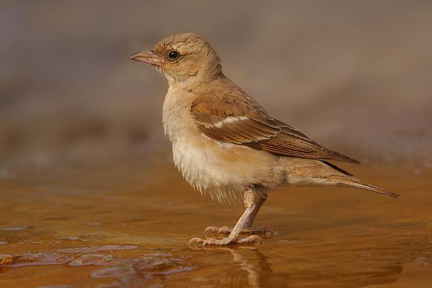
The Yellow-throated Sparrow or Chestnut-shouldered Petronia (Petronia xanthocollis)shot in Udaipur
Album:Photos of Indian Birds
Posted by Sharad Agarwal on 31st August 2011
"This is the species that converted Dr. Salim Ali to being an ornithologist. His biography "Fall of a Sparrow" refers to this species that previously had the common name "Yellow-throated Sparrow". -Gopi Sundar
|
Poem
Poem
by Sujatha Vijayaraghavan
Spiritualism and Sringara have been the soul and substance of BharataNatyam over the centuries. The present day consciousness on the other hand encompasses myriads of
thoughts, images and changing values of a fast changing world. Science and Space age,
the mores of a materialistic society, ideologies of the races, economic and political upheavals, outbreak of violence and terrorism, impact of interpersonal relationships at home
and outside, environmental crisis that strikes at the root of existence- the global village has brought these and much else into the individual and collective consciousness of homo sapiens. Stuff for high drama indeed!

How is this ushered into the realm of dance? It is done through adaptation of the words and works of thinkers, philosophers and poets. Of these the poet bears a close relation to dance, as he is the one who ultimately distills the essence of the life around
him and sublimates it into aesthetic experience and expression.
The following experimental pieces deal with both contemporary themes and forms of poetry. All of them are set to Carnatic ragams. The first theme is that of Environmental
Pollution and is depicted through two songs. The first song is in the kriti format and in the Nindhasthuthi (mock praise) mode. Neelakanta, the blue-throated Siva, who once upon a
time drank the deadly poison Halahala, is addressed here. The kriti is set to the ragam Begada and the language has the flavour of the Tamil padams of the nineteenth
century. The translation is as follows.
Ragam: Begada Lyrics & Music } Sujatha Vijayaraghavan
Talam: Adi
Pallavi
O! Neelakanta! Come hither Sir!
There’s work aplenty for Thee right now (O Neelakanta)
Anupallavi
Thou drank the Halahala I’m told –
To what avail is a mere sip of a wee bit scooped up in Thy palm? (O Neelakanta)
Charanam
In the earth, in the waters of the ocean, in the air,
We have spread poison far and wide
and thoroughly.
Show Thy prowess here, O Siva!
Show Thy prowess here, that by
drinking unto the dregs
Thou may, like Vishnu, turn blue from
top to toe (O Neelakanta)
- Translated from the original in Tamil by the author
Photo courtesy
http://ecolocalizer.com/2009/06/30/delhis-air-pollution-levels-rising-again/
|